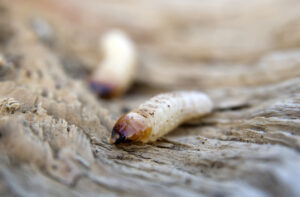
Need Help? Call Us On 0161 776 9832 For Expert Pest Control Advice On How To Identify Pest Infestations And Help Solve Your Pest Problem.
Important Tips for our Worsley Woodworm Treatment Customers
At Young’s Pest Control, we believe in an informed clientele. Our team has the training and the experience necessary to give our clients information that they will find useful in their endeavour to fight woodworm and to prevent future infestation.
 1) You will not prevent a woodworm infestation just by having a tidy home. Woodworm is the wood-boring larvae of beetles, the most common of these in the UK being the Anobium punctatum (Common Furniture Beetle), Xestobium rufuvillosum (Death Watch Beetle), Hylotrupes bajulus (House Longhorn Beetle), and Lyctus brunneus (Powder Post beetle). These beetles fly from one place to the next looking for suitable wooden furniture and other wooden structures and fixtures where they can lay their eggs. The infestation has nothing to do with cleanliness.
1) You will not prevent a woodworm infestation just by having a tidy home. Woodworm is the wood-boring larvae of beetles, the most common of these in the UK being the Anobium punctatum (Common Furniture Beetle), Xestobium rufuvillosum (Death Watch Beetle), Hylotrupes bajulus (House Longhorn Beetle), and Lyctus brunneus (Powder Post beetle). These beetles fly from one place to the next looking for suitable wooden furniture and other wooden structures and fixtures where they can lay their eggs. The infestation has nothing to do with cleanliness.
2) You should never attempt to do the spraying yourself. Avoid this common temptation because you are unlikely to know the best woodworm treatment spray for the job. At Young’s Pest Control, we know not only the best treatments but also the right quantities and where to spray. You risk contaminating surfaces and your food and/or water supply if you do the spraying yourself. Our team has the necessary personal protective equipment, meaning you will not incur this cost.
3) Your woodworm problem has not been solved just because you do not see the pests. Woodworms bore into wood, meaning they are not easily visible. Woodworm has a life cycle of several years. As an example, the Common Furniture Beetle will emerge after three years. We recommend you contact our Worsley Woodworm Treatment Specialists.
 4) The Common Furniture Beetle is by far the most common woodworm in the UK. There is a common misconception, mostly because of the name, that the woodworm targets furniture only. The fact is that the beetle has no special preference for furniture.
4) The Common Furniture Beetle is by far the most common woodworm in the UK. There is a common misconception, mostly because of the name, that the woodworm targets furniture only. The fact is that the beetle has no special preference for furniture.
5) Despite popular belief, woodworm is not only found indoors. The pests attack all wooden fixtures, indoor and outdoor. This is why our treatment for woodworm covers both the indoors and the outdoors.
6) You should know common woodworm signs so that you can call us in good time before the problem exacerbates. You should be on the lookout for such signs as small neat holes (similar to what you would find on a dart board), fine bore dust (called frass), the emergence of adult beetles from the woodwork, and crumbly edges on joists and boards. The adult beetles usually emerge from the woodwork from May to September.
7) You are more likely to find woodworm in high humidity environments. You should, therefore, keep the moisture content of your timber below 20%. Our team has timber moisture meters to tell you the exact moisture content.
8) Different jurisdictions in the UK have different laws dictating how woodworm removal should be done and the treatment for woodworm that should be used. Our team is well versed with these laws, meaning you will not find yourself on the wrong side of the law.
